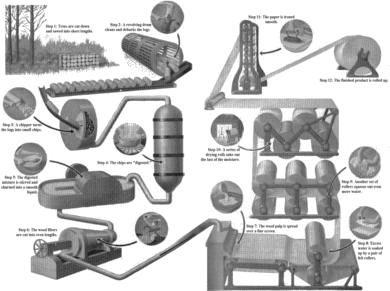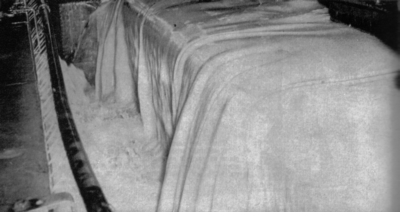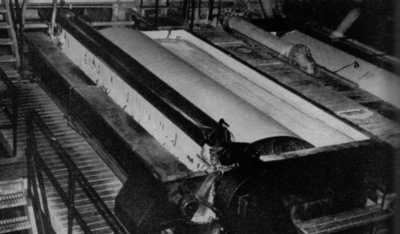 SKC Films Library |
| SKC Films Library >> Paper and Related Manufactures |
| How Paper Is Made The first machine to make paper was developed in France around 1798. Although papermaking machines have been greatly improved and enlarged since then the basic processes remain the same. A modern papermaking machine may be several hundred feet long and may turn out hundreds of tons of paper in a single day. The various steps in the papermaking process are shown in the illustration below. Continue on down the page for a step-by-step explanation of the process. Step 1: Gathering the Raw Material Paper can be made from almost any fibrous material. The Arabs used to make it out of linen and flax and rags, or out of various vegetable fibers. We still use all of these things and many others -- hemp and jute, cornstalk, straw, old rope, bamboo, and many others -- but the main thing we use is wood. At one time thousands of square miles of trees had to be cut down in order to make just a few hundred feet of paper, but modern plants frequently use scraps left over from lumber mills and the parts of trees that are too small to make into lumber, as well as trees specially grown for the paper mill. Step 2: Cleaning the Raw Material Whole trees must be cut into managable lengths and then stripped of their bark before the papermaking process can begin. The debarking is typically done by a revolving drum in which projecting blades cut away the bark and leave a fairly smooth log. The logs must also be washed down to remove loose dirt and foreign objects. Lumber mill scraps can usually skip the debarking process but must still be cleaned before proceeding to the next step. Step 3: Chipping Once debarked and cleaned the logs/scraps are sent to a huge machine that reduces them to uniformly-sized chips. Step 4: Digesting The wood chips are dumped into a huge cylinder called a "digester," in which they are soaked in a bath of chemicals -- mainly bisulphite of lime -- and cooked under pressure for about eight hours. All wood contains, along with the cellulose that make paper, a great deal of other material that will slowly decay; the digesting process removes this other material, leaving just the cellulose. Step 5: Beating and Churning The digested mixture is passed to a machine that beats and churns it. The mixture goes in with a consistency much like that of cottage cheese and comes out as a smooth milky liquid similar to that of thin latex paint. the digested mixture is beaten and
churned Step 6: "Setting" of Fibers The mixture then goes into the Jordan Engine, a huge revolving tank with revolving blades that cut the wood fibers into even lengths. It is at this stage that various "fillers" -- such as talc or china clay -- and/or "sizing agents" are added. These fillers and sizers are what give the finished paper its specific color, strength, and fineness/roughness of writing surface. The mixture is now ready to be turned into what we recognize as paper. Step 7: Screening The now latex-consistency pulp mixture passes through a strainer that takes out any remaining lumps and is then sent to the machine which will turn into paper. The pulp mixture runs as a filmy sheet or "web" upon a fast-moving belt of fine copper-wire mesh. The belt carries it along, letting the water drip out of it and also drawing the water out by suction; and it shakes the pulp a bit from side to side to settle the fibers firmly. Toward the end of the trip on the wire belt the sheet may pass under what is known as a "dandy roll" where it receives a watermark. the wood pulp mixture is passed to
the screeners Step 8: Blotting From the "dandy roll" the pre-paper product passes through a pair of felt rollers that "blot up" much of the leftover water. the wood pulp mixture is starting
to look like one giant sheet of paper Step 9: Squeezing The sheet then passes through a series of steel rollers that squeeze even more water out, as well as help stiffen the sheet. Step 10: Drying The final set of drying rollers are heated from the inside and remove the last traces of moisture. Step 11: Ironing The final stage involves sending the long sheet through what is known as a Calendar Stack. This stack of rollers "irons" the sheet flat. The more rolls there are in the stack, the smoother the paper becomes. The finished paper is rolled up and the process is complete. PRINT SOURCE WEB SOURCE |
| SKC Films Library >> Paper and Related
Manufactures This page was last updated on July 07, 2018. |



